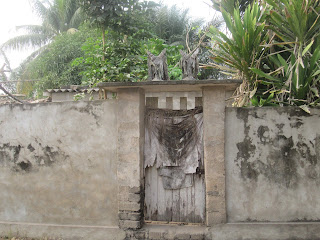A had a walking tour around the local village. It had seen better days and there were many deserted buildings. A view down a side street in a lived in area.
One of the many derelict buildings. built in 1932 but now abandoned.
Another derelict building. Our tourist ministery guide said it was due to encroachment by the sea but the translator said it was due to fighting during the civil war.
The area is the birth place of voodoo and every village has its guardian diety where offerings are made.
Then we had a boat ride along the river.
The area is important for two major products, fish as in the first basket...
and salt as in the lady's other basket.
This a fish trap, but usually they are set at the bottom of the river rather than this one that has been left dry by the falling tide.
A selection of sea food caught, a shrimp. langoustine and a fish.
Another voodoo good luck diety. This one was to guard against slave traders, and it would wake up the village if they came near.The entrance to a voodoo temple, but only initiates can enter.
On the beach was a turtle sanctuary where several types of young turtles are rescued.
Baby leather back turtles.
Near the centre of the town is the Portuguese fort where slaves were housed until sold and put on ships to be taken across the Atlantic to the Carribbean.
The governors house inside the fort.
The old tree where the slaves were bought and sold. It was from here that they walked down the Slave Road for the 4kms to board ships.
There are various stations all the way down to the coast. One was the Tree of No Return. Slaves would walk around it nine times to gorget their past but also to ensure that their spirit returned to their native land wherever they died.
The Door of No Return. This is a modern interpretation and there was no actual door here but several of the other slave forts had a similar door from which they left the fort to board a ship and never to return.
Next I went to a stilted village in a large lake just along the coast. We boarded a boat to take the one hour journey across the lake to the sailed village.
The lake is shallow and a heaven for fish. The fishermen push palm fronds into the soft lake bed to corral the fish into certain areas so that they are easier to catch.
One of the many houses on stilts.
The hotel and bar in the centre of the village. In front of it is the local market where traders paddle their boats loaded with goods to sell.
A close up of some of the traders boats.
One of the many boats that carry palm fronds onto the lake for the fishermen to use.
And lastly, how many can you get on a motor bike. A new record for me with five people on one bike. If it doesn't happen in Africa, it doesn't happen. But now I am looking for six people on a bike!



























No comments:
Post a Comment